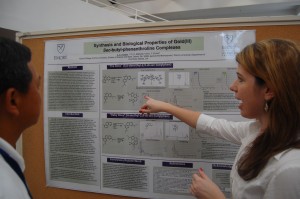This week a variety of media outlets and science-oriented Web sites had fun with research at Emory — published recently in PNAS — investigating a gene that appears to limit some forms of learning and memory.
Mice with a disabled RGS14 gene remembered objects in their cages more easily and learned to navigate water mazes better, pharmacologist John Hepler and his colleagues found. Since the presence of a functional RGS14 gene holds mice back mentally, Hepler and his colleagues have been jokingly calling it “the Homer Simpson gene.”
This description struck a chord; the Atlantic magazine even embellished the story with a video showing the “D’oh”-ey cartoon character evolving from a single cell into a human couch potato.
It’s important to recognize that smart mice are not so surprising to scientists anymore. Back in 1999, scientists at Princeton announced the creation of “Doogie Howser” mice (named after a precocious doctor from another TV series). These critters performed better than normal lab mice in some of the same tests that Hepler’s team used to evaluate the RGS14-deleted mice.
One important difference: the Doogie mice had all their normal genes, and were overproducing a NMDA receptor gene involved in helping neurons communicate. Still, as a helpful 2009 round-up in Nature Reviews Neuroscience explains, scientists have found several single-gene knock-out mice that do better on tests of learning and memory. Many of these genetic alterations affect the process of long term potentiation, a process where neurons that get stimulated at the same time have the connections between them grow stronger.

RGS14 is turned on primarily in the CA2 region of the hippocampus
What makes the RGS14 gene an intriguing case is that it’s primarily turned on in the enigmatic CA2 region of the hippocampus. The CA2 region is normally relatively resistant to long-term potentiation and is also more hardy in situations of stroke or seizure.
Hepler observes that the vasopressin receptor 1b gene is also turned on predominantly in the CA2 region, and seems to be involved in aggression and social memory. He and his colleagues are planning to examine whether the RGS14-disabled mice have altered capabilities in those areas. Conveniently, Larry Young’s laboratory at Yerkes National Primate Research Center has been investigating the functions of vasopressin receptors in voles.
One last note: scientists in Spain have reported in Science that they can generate a variety of smart mice by putting the RGS14 gene on overdrive in a part of the brain where it’s not usually turned on. So whatever precise function RGS14 has, it doesn’t always dumb things down.







![eczema gentian violet[1]_Page_3](http://www.emoryhealthsciblog.com/wp-content/uploads/2010/09/eczema-gentian-violet1_Page_3-298x300.jpg)


